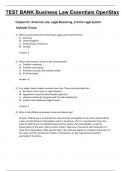TEST BANK Business Law Essentials OpenStax
Chapter 01: American Law, Legal Reasoning, and the Legal System
Multiple Choice
1) Which country does the United States legal system derive from?
a) Germany.
b) United Kingdom.
c) United States of America.
d) Canada.
Answer: b
2) What is the function of law in the United States?
a) Establish standards.
b) Promote consistency.
c) Promote, provide, and maintain order.
d) All of the above.
Answer: d
3) As a judge, Baxter applies common law rules. These rules develop from
a) decisions of the courts in legal disputes.
b) regulations issued by administrative agencies.
c) statutes enacted by Congress and the state legislatures.
d) uniform laws drafted by legal scholars.
Answer: a
4) What is the difference between state and federal law?
Answer: Federal law is created at the national level, and applies to the entire nation (all 50
states and the District of Columbia), and U.S. territories. The U.S. Constitution forms the
basis for federal law; it establishes government, power and responsibility, as well as
preservation of the basic rights of every citizen. State law is the law of each separate U.S.
state and is applicable in that specific state. The state law applies to residents and visitors of
the state, and also to business entities, corporations, or any organizations based or
operating in that state.
,5) The legislature of the state of Wyoming enacts a new statute that sets standards for the
liability of businesses selling defective products. This statute applies in:
a) Wyoming only.
b) only Wyoming and its bordering states.
c) all states.
d) all states but only to matters not covered by other states’ laws.
Answer: a
6) Alex has been sued by Will for failure to pay rent for their apartment which source of law
will govern this lawsuit?
a) Administrative law.
b) The Constitution.
c) Civil Law.
d) Criminal Law.
Answer: c
7) Four sources of law in the U.S. legal system are:
a) Constitutional law, criminal law, civil law, and maritime law.
b) Federal law, state law, international law, and maritime law.
c) Statutory law, case law, equity, and common law.
d) Constitutional law, judicial law, legislative law, and administrative law.
Answer: d
8) Where can you find a codification of federal laws?
a) The library.
b) Federal Court.
c) United States Code.
d) U.S. Library of Congress.
Answer: c
9) What is the supreme law of the land? What are statutes? What are ordinances? What is an
administrative rule?
Answer: What is the supreme law of the land? The federal constitution is the supreme law
of the land. What are statutes? Laws enacted by Congress or a state legislative body. What
are ordinances? Laws enacted by local legislative bodies. What are administrative rules?
Laws issued by administrative agencies under the authority given to them in statutes.
10) Regulations are:
a) Laws passed by Congress.
, b) Rules made by local governments.
c) Derived from decisions made by judges.
d) Rules adopted by administrative agencies.
Answer: d
11) What is an Unfair Trade Practice and which Administrative Agency regulates it?
Answer: The term “unfair trade practices” is broadly used and refers to any deceptive or
fraudulent business practice or act that causes injury to a consumer. Some examples
include, but are not limited to, false representations of a good or service including
deceptive pricing, non-compliance with manufacturing standards, and false advertising. The
FTC investigates allegations of unfair trade practices raised by consumers and businesses,
pre-merger notification filings, congressional inquiries, or reports in the media and may
seek voluntary compliance by offending businesses through a consent order, administrative
complaints, or federal litigation.
12) Some of the rights in the Constitution’s Bill of Rights extends to Corporations.
a) True.
b) False.
Answer: a
13) Forms of Alternative Dispute Resolution (“ADR”) include all of the following except:
a) Mediation.
b) Settlement.
c) Litigation.
d) Arbitration.
Answer: c
14) Consequences of being convicted a crime include all of the following except:
a) Prison.
b) Fines.
c) Community service.
d) Damages.
Answer: d
15) Securities are only regulated by federal laws.
a) True.
b) False.
Answer: b
, Chapter 02: Disputes and Dispute Settlement
Multiple Choice
1) A process in which a third party selected by the disputants helps the parties to voluntary
resolve their disagreement is known as:
a) Mediation.
b) Discovery.
c) Arbitration.
d) Settlement.
Answer: a
2) What’s the first step in Alternative Dispute Resolution?
a) Conciliation.
b) Mediation.
c) Negotiation.
d) Arbitration.
Answer: c
3) What’s the definition of negotiation?
Answer: The process by which parties with nonidentical preferences allocate resources
through interpersonal activity and joint decision making.
4) How does the process of negotiation work?
Answer: In the process of negotiation, the parties come together informally, with or without
attorneys to represent them. Within this informal setting the parties air their differences
and try to reach a settlement or resolution without the involvement of independent third
parties. Because no third parties are involved and because of the informal setting,
negotiation is the simplest form of alternative dispute resolution.
5) Explain the Thomas-Kilmann Conflict Mode Instrument.
Answer: The Thomas-Kilmann Conflict Mode Instrument (TKI) is a questionnaire that
provides a systematic framework for categorizing five broad negotiation styles. It is closely
associated with work done by conflict resolution experts Dean Pruitt and Jeffrey Rubin.
These styles are often considered in terms of the level of self-interest, instead of how other
negotiators feel. These five general negotiation styles include:
Forcing. If a party has high concern for itself, and low concern for the other party, it may
adopt a competitive approach that only takes into account the outcomes it desires. This




